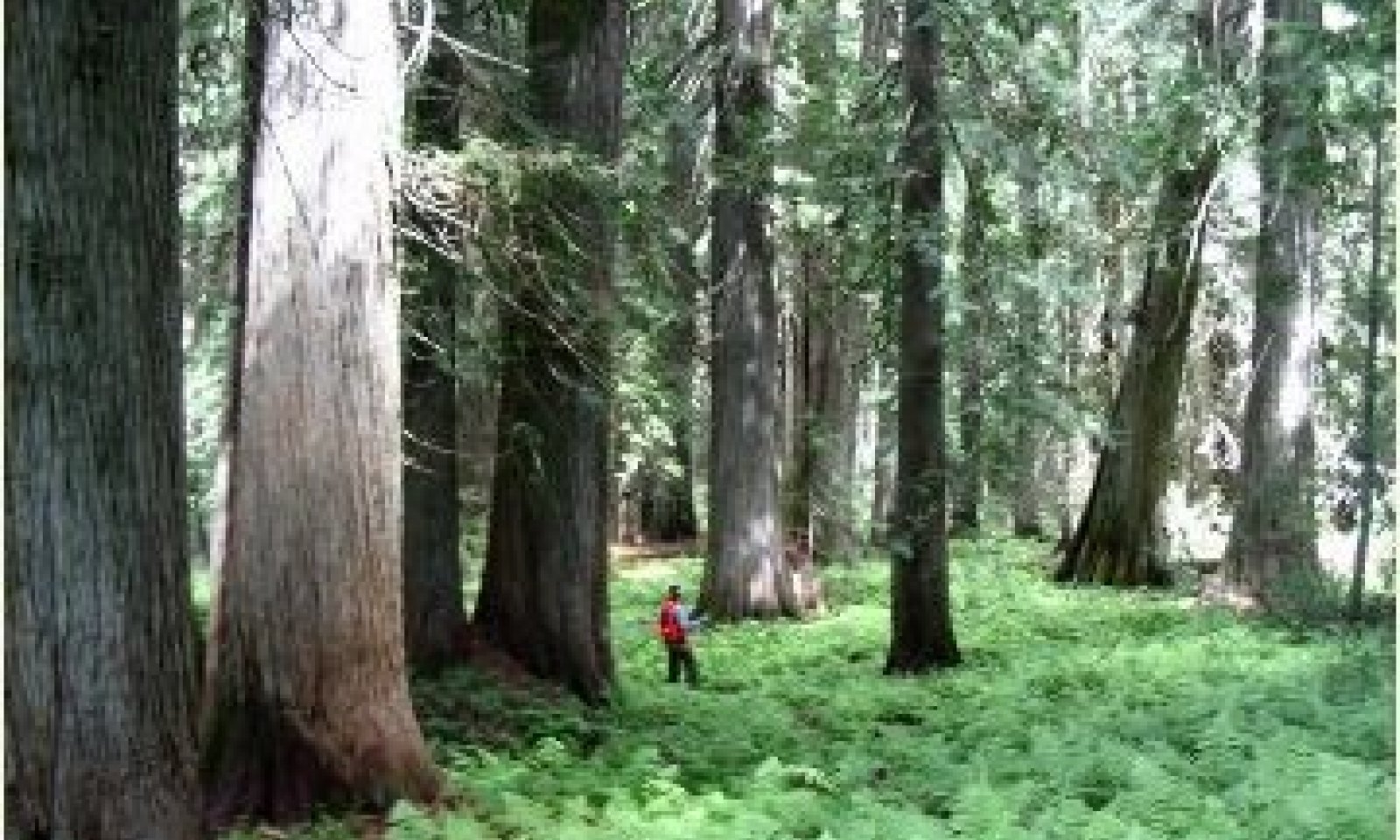

Natural Resources
Conservation Service
Ecological site F043AY577ID
Ashy Depressions 35"+ PZ Frigid
Last updated: 10/23/2020
Accessed: 12/22/2024
General information
Provisional. A provisional ecological site description has undergone quality control and quality assurance review. It contains a working state and transition model and enough information to identify the ecological site.
MLRA notes
Major Land Resource Area (MLRA): 043A–Northern Rocky Mountains
Major Land Resource Area (MLRA): 043A–Northern Rocky Mountains
Description of MLRAs can be found in: United States Department of Agriculture, Natural Resources Conservation Service. 2006. Land Resource Regions and Major Land Resource Areas of the United States, the Caribbean, and the Pacific Basin. U.S. Department of Agriculture Handbook 296.
Available electronically at: http://www.nrcs.usda.gov/wps/portal/nrcs/detail/soils/ref/?cid=nrcs142p2_053624#handbook
LRU notes
Modal LRU – 43A10 - Clearwater Mountains
This LRU is composed predominantly of mid to high elevation mountain slopes, and valley walls. The soils tend to be loamy andisols, and inceptisols with distinct ash surfaces. Colluvium or residuum from granitic or metamorphic rock are the dominant parent materials. Soil climate is a frigid or cryic temperature regime and udic moisture regime with average annual precipitation around 1330 mm (54 inches).
Others where occurring – 43A09 - Western Bitterroot Foothills
43A11 - Bitterroot Metasedimentary Zone
Classification relationships
Relationship to Other Established Classifications:
United States National Vegetation Classification (2008), A3612 Western Hemlock – Western Redcedar Cool-Mesic Central Rocky Mountain Forest & Woodland Alliance.
Washington Natural Heritage Program. Ecosystems of Washington State, A Guide to Identification, Rocchio and Crawford, 2015 - Northern Rocky Mt. Mesic Montane Mixed Conifer Forest (Cedar-Hemlock)
Description of Ecoregions of the United States, USFS PN # 1391, 1995 - M333 Northern Rocky Mt. Forest-Steppe-Coniferous Forest-Alpine Meadow Province
Level III and IV Ecoregions of WA, US EPA, June 2010 – 15y Selkirk Mountains, 15w Western Selkirk Maritime Forest.
This ecological site includes the following USDA Forest Service Plant Associations Western Redcedar Series: THPL/GYDR, THPL/ADPE, THPL/ATFI. (Williams et. al. 1995)
Ecological site concept
This ES group is distinguished by an overstory of western redcedar, grand fir and Douglas-fir and a diverse understory of ferns such as western oakfern, maidenhair fern and ladyfern; and herbs such as bride’s bonnet, Idaho goldthread, coolwort foamflower, wild ginger and starry false solomon’s seal. It occurs on lower slope of foothills or mountainsides, and in river valleys. These soils have developed in various thicknesses of Mazama tephra deposits (often highly mixed with loess) over a number of other parent materials. These parent materials are dominantly: alluvium and material weathered from granite, gneiss or schist. The soils have adequate available water holding capacity within 40 inches. About half of the components have either a perched or apparent water table within 30 inches of the soil surface. They are very poorly to well drained and are in positions of moisture accumulation.
Table 1. Dominant plant species
| Tree |
(1) Thuja plicata |
|---|---|
| Shrub |
(1) Acer glabrum |
| Herbaceous |
(1) Gymnocarpium dryopteris |
Physiographic features
Physiographic Features
This ecological site occurs mainly on foot slopes and drainageways of mountains and hills. Parent materials are alluvium or residuum and colluvium derived from igneous (granitic) and metamorphic rock mantled by volcanic ash and loess.
Landscapes: Mountains, Foothills, River Valleys
Landforms: Mountain slopes, Hillslope, Stream Terraces, Floodplains, Drainageways, Valley Floors
Elevation:
Total range = 488 to 1530 m
(1,600 to 5,020 feet)
Central tendency = 735 to 1060 m
(2,4105 to 3,470 feet)
Slope (percent):
Total range = 0 to 75 percent
Central tendency = 10 to 35 percent
Aspect: none dominant
Table 2. Representative physiographic features
| Landforms |
(1)
Mountains
> Mountain slope
(2) Foothills > Hillslope (3) River valley > Valley floor (4) Foothills > Drainageway (5) River valley > Stream terrace (6) River valley > Flood plain |
|---|---|
| Flooding duration |
Not specified |
| Flooding frequency | None |
| Ponding frequency | None |
| Elevation | 735 – 1,058 m |
| Slope | 10 – 35% |
| Water table depth | 71 cm |
| Aspect | Aspect is not a significant factor |
Table 3. Representative physiographic features (actual ranges)
| Flooding duration | Very long (more than 30 days) |
|---|---|
| Flooding frequency | None to frequent |
| Ponding frequency | None |
| Elevation | 488 – 1,530 m |
| Slope | 0 – 75% |
| Water table depth | 0 – 203 cm |
Climatic features
Climatic Features
The climate of this portion of the MLRA is controlled by a combination of large-scale and small-scale factors. The large-scale factors include latitude, relative position on the North American continent, prevailing hemispheric wind patterns, and extensive mountain barriers. Small-scale or local factors include the topographic setting and position (valley, slope, or ridge location), as well as orientation or aspect, and vegetative cover. Broadly, the climate is transitional between a northern Pacific coastal type and a continental type. The Pacific influence is noted particularly by the late autumn and winter maximum in cloudiness and precipitation and in the relatively moderate average winter temperatures, compared with areas east of the Rocky Mountains. Summer is characteristically sunny and dry, though July and August are the only distinct summer months. July and August are thus also the peak fire-danger months. Annual precipitation (rain and melted snow) averages as little as 10 inches at the lowest canyon floors; over 100 inches at the highest elevations. Wettest months are normally November, December, and January. Close to 60 percent of the annual total occurs during the period November through March. A slight, secondary peak in precipitation normally appears in May and June, followed by a sharp decrease in July. Snowfall accounts for more than 50 percent of the total precipitation at elevations above 4,800 ft. Snow cover usually persists in the mid elevation valleys from early December through the end of March. High-elevation snowpack reaches a depth of 5 ft or more in March and April and may linger into June. The main season of lightning (or thunderstorm) activity extends from late May through August. Storms occur on an average of 3 or 4 days each in June, July, and August. Monthly mean temperatures in populated valley locations range from 24 F (-4 C) in January to 65 F (18 C) in July; these are midpoint values between the average daily maximum and minimum temperatures. The annual mean is 43 F (6 C). A large diurnal range occurs in summer. Extreme temperatures have been as high as 103" to 105" F (about 40" C) and as low as -36" F (-38" C). Temperature inversions are commonplace, particularly on the clear summer and early autumn nights. The frost-free season, defined as the period with minimum temperatures staying above 32" F (0" C), varies widely with elevation and topographic position. The season is generally longer at lower elevation locations and on slope positions in the "thermal belt" around 3,500 ft. The season is shorter in positions affected by cold air drainage and slopes above the “thermal belt” at elevations >5,500 ft. Relative humidity is usually high throughout the day in late autumn and winter, averaging 70 to 80 percent or higher in midafternoon. In July and August, afternoon values average near 35 percent in the mid elevation valleys and 45 percent at 5,500 ft. Summer nighttime humidity in these valleys typically recovers to over 90 or 95 percent by dawn. On the slopes above the temperature inversion, at the same time, humidity may average only 50 to 60 percent. Winds have a prevailing (most frequent) direction from the southwest during all or most of the year. Local terrain effects modify the larger-scale wind that occurs in the adjacent free atmosphere. A nighttime drainage effect is common. Sunshine duration is at a minimum in December, when it may average only 20 percent of the maximum possible. July has close to 80 percent of the maximum possible.
(from Finklin, A. 1983. Climate of Priest River Experimental Forest, Northern Idaho.GTR-INT-159)
Frost-free period (days):
Total range = 60 to 135 days
Central tendency = 90 to 110 days
Mean annual precipitation (cm):
Total range = 530 to 1405 mm
(21 to 55 inches)
Central tendency = 770 to 1035 mm
(30 to 41 inches)
MAAT (C)
Total range = 4.9 to 9.9
(41 to 50 F)
Central tendency = 6.7 to 8.0
(44 to 46 F)
Climate stations: Enaville, Mullan
Influencing water features
Water Table Depth: 54% of components have no observed water table (> 80 inches)
Where water table occurs (46% of components): range is 0 to 30 inches (median = 18 inches) during Dec-May
Flooding:
Frequency: None to Frequent
Duration: None to Very Long
Ponding:
Frequency: None
Duration: None
Soil features
Representative Soil Features
This ecological site is associated with several soil components (e.g. Floodwood, Odonnell, Chatcolet, Aquic Udifluvents, Dorb, Grandad, Hubub, Bouldercreek, Ramsdell, Seelovers, and Porrett). The soil components can be grouped into Endoaquepts, Endoaquolls, Epiaqualfs, Hapludalfs, Udifluvents, and Udivitrands. These soils have developed in various thicknesses of Mazama tephra deposits (often highly mixed with loess) over a number of other parent materials. These parent materials are dominantly: alluvium and material weathered from granite, gneiss or schist. The soils have adequate available water holding capacity within 40 inches. About half of the components have either a perched or apparent water table within 30 inches of the soil surface. They are very poorly to well drained and are in positions of moisture accumulation.
Table 4. Representative soil features
| Parent material |
(1)
Volcanic ash
(2) Alluvium (3) Colluvium – granite (4) Colluvium – metamorphic rock |
|---|---|
| Surface texture |
(1) Ashy silt loam (2) Medial silt loam (3) Cobbly, ashy silt loam |
| Drainage class | Moderately well drained |
| Permeability class | Moderately slow |
| Depth to restrictive layer | 203 cm |
| Surface fragment cover >3" | 0% |
| Available water capacity (0-101.6cm) |
17.27 cm |
| Calcium carbonate equivalent (0-152.4cm) |
0% |
| Electrical conductivity (0-152.4cm) |
0 mmhos/cm |
| Soil reaction (1:1 water) (0-152.4cm) |
6.2 |
| Subsurface fragment volume >3" (25.4-152.4cm) |
2% |
Table 5. Representative soil features (actual values)
| Drainage class | Very poorly drained to well drained |
|---|---|
| Permeability class | Slow to moderate |
| Depth to restrictive layer | 51 – 203 cm |
| Surface fragment cover >3" | 0% |
| Available water capacity (0-101.6cm) |
9.4 – 21.59 cm |
| Calcium carbonate equivalent (0-152.4cm) |
0% |
| Electrical conductivity (0-152.4cm) |
0 mmhos/cm |
| Soil reaction (1:1 water) (0-152.4cm) |
5.3 – 7.3 |
| Subsurface fragment volume >3" (25.4-152.4cm) |
0 – 65% |
Ecological dynamics
Ecological Dynamics of the Site
This ecological site is highly diverse in tree species, shrub and forb composition. Forest composition is dependent of fire severity, occurrence, and tree species seed source after fire. Western white pine used to dominate stands after stand replacing fires before the white pine blister rust. Now, western larch, Douglas-fir, lodgepole, and ponderosa pine (dry exposures) have replaced it. Grand fir western hemlock, and western red cedar also get established but sit in understory underneath the other species until release from canopy openings. Hemlock occurrence is limited to stands north of the North Fork Clearwater River. Engelmann spruce occurs in areas affected by cold air drainage. In early stands after fire Quaking aspen, paper birch, and black cottonwood will be present only to be overtopped in later years. Shrub competition can be severe after fire with many shrub species dominating the site. Red stem ceanothus or snowbrush ceanothus (drier areas) or Scouler willow (wetter sites) can dominate sites with severe burns. Mixed severity fires create a patchy mosaic of all tree species being present. Reference condition comprise the “giant cedar groves” with high canopies and moist understories. Very large western redcedar and grand fir dominate old growth and often younger stands as well. Seral species vary, depending on temperature and drainage conditions. These sites will have fire intervals of over 200 years for stand replacing fires. Relic western larch, Douglas-fir, and ponderosa pine may be present.
State and transition model
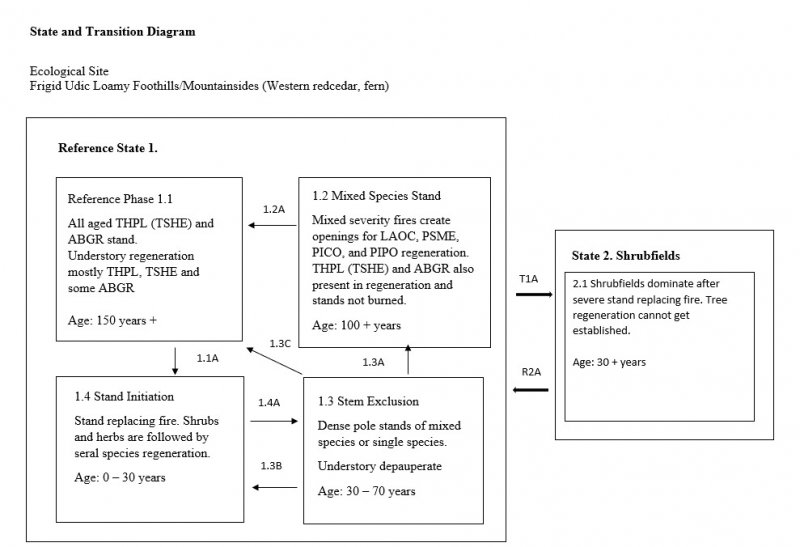
More interactive model formats are also available.
View Interactive Models
More interactive model formats are also available.
View Interactive Models
Click on state and transition labels to scroll to the respective text
Ecosystem states
State 1 submodel, plant communities
State 2 submodel, plant communities
State 1
Reference
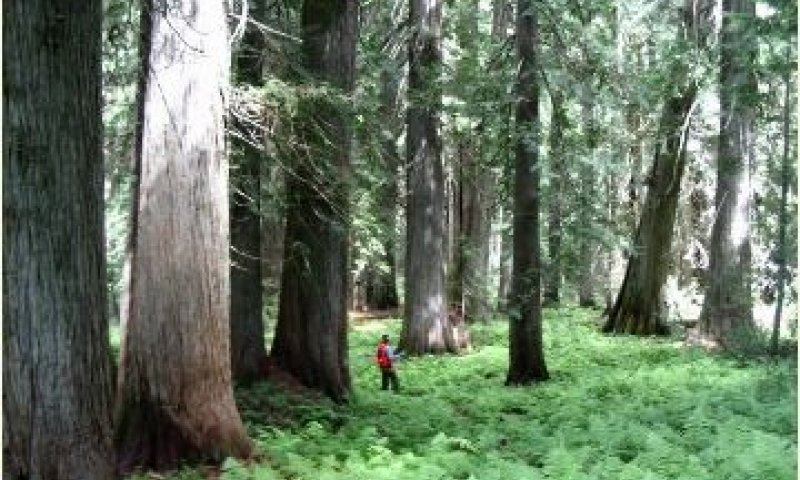
This state with extended fire intervals turns into an all aged western redcedar stand with some grand fir and/or western hemlock present. Stand development after fire depends on fire size and severity, as well as changes in drainage and microclimate. Since severe fires are accompanied by stand removal over a large geographic area, stand-replacing fire may be followed by a significant rise in the water table. Salix scouleriana often dominates such wet sites. Canopy removal also increases the likelihood of frosty conditions, favors shrub dominance, and retards establishment of the ferns and herbs characteristic of climax stands. Reforestation may require more than 100 years. The tree species that establish on burns vary with postburn conditions. Shade-tolerant species are favored in small openings, especially if duff is not removed. In larger openings, hardwoods and shade-intolerant conifers can overtop climax species and so dominate early seral stages. Black cottonwood is often important in such stands. On sites with good drainage, western white pine, western larch, and Douglas-fir all occur. Cold conditions favor Engelmann spruce and occasional lodgepole pine. Rotting logs are the best microsites for tree establishment; root crowns of fallen trees are also good seedbeds. With successful tree regeneration a mix of seral tree species can occupy the stand or in some cases, a single species like western larch will dominate the stand. These stands go into the stem exclusion phase with tree to tree competition. Understory vegetation will be sparse. As these stands mature mixed severity fires create a mosaic of stand structure and species composition with a combination of seral species and shade tolerant cedar, hemlock and grand fir. Old-growth stands develop an open canopy composed of large, evenly spaced trees, with mostly cedar or hemlock regeneration beneath. The most vigorous understory trees originate in canopy gaps, not in shade (Smith and Fisher, 1997).
Community 1.1
Reference

These are very moist forests forests in northern Idaho. They comprise the“giant cedar groves” with high canopies and moist understories. Most are in valley bottoms or on lower slopes with high water tables. Very large western redcedar and grand fir dominate old growth and often younger stands as. Seral species vary, depending on temperature regime and drainage conditions. In these stands, Acer glabrum, Alnus sinuata, Oplopanax horridum, Salix scouleriana, and Taxus brevifolia can grow very large. Ferns, especially Adiantum pedatum, Athyrium filix-femina, and Gymnocarpium dryopteris, are conspicuous in the understory. Woody fuels may be light or heavy, depending on site history, stand structure, and moisture conditions. High rates of decomposition, especially in old-growth stands, often contribute to relatively low woody fuel loadings. Most of these stands persist for many centuries without severe fire. Widespread occurrence of shade-intolerant species, however, indicates a history that included occasional severe fire. (Smith and Fischer, 1997)
Dominant plant species
-
western redcedar (Thuja plicata), tree
-
grand fir (Abies grandis), tree
-
Engelmann spruce (Picea engelmannii), tree
-
Rocky Mountain maple (Acer glabrum), shrub
-
thimbleberry (Rubus parviflorus), shrub
-
longtube twinflower (Linnaea borealis ssp. longiflora), shrub
-
dwarf rose (Rosa gymnocarpa), shrub
-
Utah honeysuckle (Lonicera utahensis), shrub
-
Pacific yew (Taxus brevifolia), shrub
-
common snowberry (Symphoricarpos albus), shrub
-
thinleaf huckleberry (Vaccinium membranaceum), shrub
-
Columbia brome (Bromus vulgaris), grass
-
western oakfern (Gymnocarpium dryopteris), other herbaceous
-
common ladyfern (Athyrium filix-femina), other herbaceous
-
northern maidenhair (Adiantum pedatum), other herbaceous
-
Idaho goldthread (Coptis occidentalis), other herbaceous
-
threeleaf foamflower (Tiarella trifoliata), other herbaceous
-
bride's bonnet (Clintonia uniflora), other herbaceous
-
threepetal bedstraw (Galium trifidum), other herbaceous
-
British Columbia wildginger (Asarum caudatum), other herbaceous
-
starry false lily of the valley (Maianthemum stellatum), other herbaceous
-
Pacific trillium (Trillium ovatum), other herbaceous
Community 1.2
Mixed Species Stand
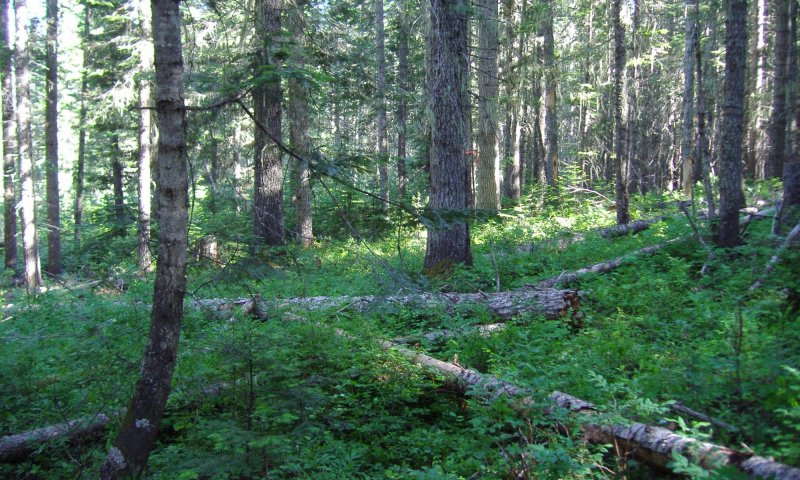
Mixed severity fires create a mosaic of mixed tree species. Western larch, Douglas-fir, western white pine, ponderosa pine (drier sites), and lodgepole pine can compose the stand. Cedar and grand fir will be mixed into the stand structure. Quaking aspen, black cottonwood and paper birch can be part on these mosaic stands.
Dominant plant species
-
grand fir (Abies grandis), tree
-
Rocky Mountain Douglas-fir (Pseudotsuga menziesii var. glauca), tree
-
western redcedar (Thuja plicata), tree
-
western larch (Larix occidentalis), tree
-
western white pine (Pinus monticola), tree
Community 1.3
Stem Exclusion
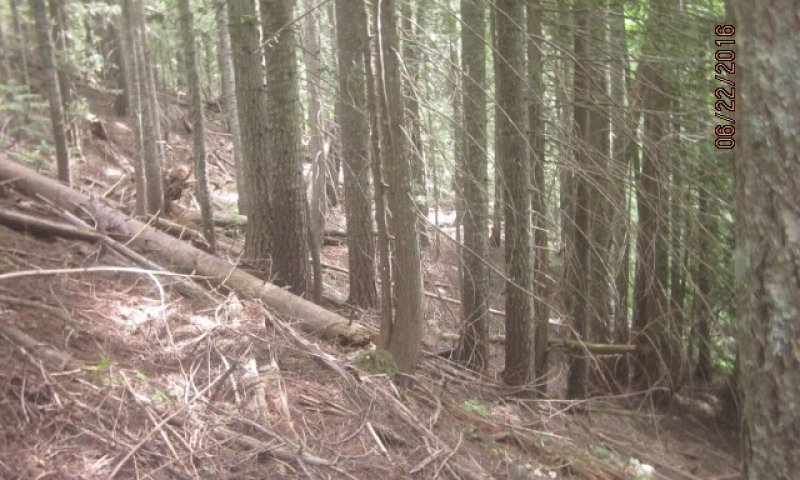
Dense pole size stand competition. Stands composed of mixed seral species or in some cases only cedar
Dominant plant species
-
grand fir (Abies grandis), tree
-
western redcedar (Thuja plicata), tree
-
Rocky Mountain Douglas-fir (Pseudotsuga menziesii var. glauca), tree
Community 1.4
Stand Initiation

Shrub and herb phase with tree regeneration depending on seed source. Single species regeneration such as western larch or mixed with larch, Douglas-fir, white pine, grand fir and cedar. Ponderosa pine establishment mostly on drier warmer sites. Lodgepole pine establishment possible on hotter burn sites. Shrubs can dominate for long periods preventing tree establishment
Pathway 1.1A
Community 1.1 to 1.4


Stand replacing fire
Pathway 1.2A
Community 1.2 to 1.1


Fire interval extended to allow shade tolerant cedar and grand fir to grow up from understory to dominate stand.
Pathway 1.3C
Community 1.3 to 1.1


Time, fire interval extended to allow cedar and grand fir to dominate stand. No disturbance to allow seral species to dominate.
Pathway 1.3A
Community 1.3 to 1.2


Time, allowing stands to reach maturity before a stand replacing fire. Mixed severity fires then occur.
Pathway 1.3B
Community 1.3 to 1.4


Stand replacing fire in dense pole stands.
Pathway 1.4A
Community 1.4 to 1.3


Time, allowing tree regeneration to grow into pole stands
State 2
Shrubfields
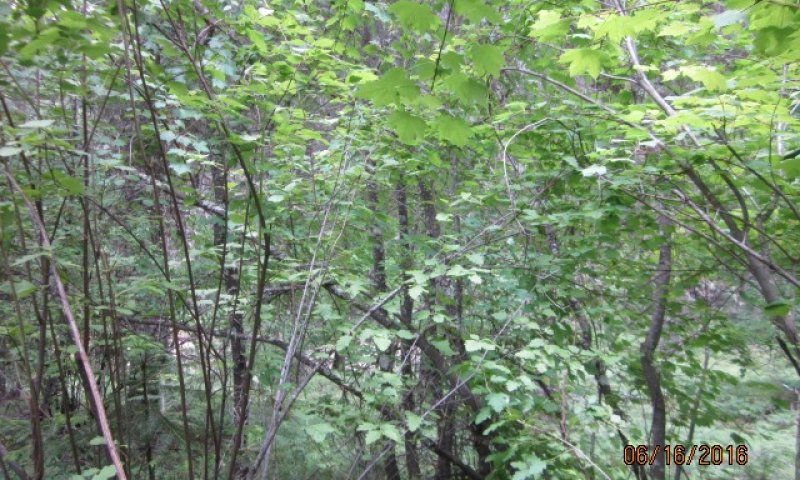
Severe fires change reference state to a shrubfield site. No tree regeneration due to shrub competition and soil conditions. Major shrubs include snowbrush and redstem ceanothus, serviceberry, ninebark, Scouler willow, elderberry species, snowberry, spirea, and Douglas maple
Dominant plant species
-
ceanothus (Ceanothus), shrub
-
Saskatoon serviceberry (Amelanchier alnifolia), shrub
-
mallow ninebark (Physocarpus malvaceus), shrub
-
Scouler's willow (Salix scouleriana), shrub
-
red elderberry (Sambucus racemosa), shrub
-
common snowberry (Symphoricarpos albus), shrub
-
white spirea (Spiraea betulifolia), shrub
-
Rocky Mountain maple (Acer glabrum), shrub
Community 2.1
Reference
Severe fires change reference state to a shrubfield site. No tree regeneration due to shrub competition and soil conditions. Major shrubs include snowbrush and redstem ceanothus, serviceberry, ninebark, Scouler willow, elderberry species, snowberry, spirea, and Douglas maple
Transition T1A
State 1 to 2


Severe fires creating shrubfields preventing tree establishment for long time periods.
Restoration pathway R2A
State 2 to 1


Site by site analysis to determine tree planting survival. Tree planting species mostly seral species like, larch, Douglas-fir, ponderosa pine, and white pine (blister rust resistant).
Additional community tables
Interpretations
Table 6. Representative site productivity
| Common name | Symbol | Site index low | Site index high | CMAI low | CMAI high | Age of CMAI | Site index curve code | Site index curve basis | Citation |
|---|---|---|---|---|---|---|---|---|---|
| western white pine | PIMO3 | 75 | 110 | 144 | 201 | 100 | – | – | |
| grand fir | ABGR | 76 | 124 | 106 | 201 | 95 | – | – | |
| Rocky Mountain Douglas-fir | PSMEG | 64 | 98 | 65 | 152 | 104 | – | – | |
| western larch | LAOC | 56 | 93 | 74 | 146 | 70 | – | – | |
| Rocky Mountain Douglas-fir | PSMEG | 66 | 100 | 56 | 130 | 88 | – | – |
Supporting information
References
-
. Idaho Department of Lands H.T. Groupings based on Forest HTs of Northern Idaho.
-
Cooper, S.V., K.E. Neiman, R. Steele, and D.W. Roberts. 1991. Forest Habitat types of Northern Idaho, A Second Approximation.
-
Finklin, A.I. 1983. Climate of Priest River Experimental Forest, northern Idaho. Gen. Tech. Rep. INT-159. U.S. Department of Agriculture, Forest Service, Intermountain Forest and Range Experiment Station, Ogden, UT. 53.
-
McDonald, G.L., A.E. Harvey, and J.R. Tonn. 2000. Fire, Competition, and Forest Pests: Landscape Treatment to Sustain Ecosystem Functions, The Joint Fire Science Conference and Workshop.. Pages 195–211 in Proceedings from the Joint Fire Science Conference and Workshop: crossing the millennium: integrating spatial technologies and ecological principles for a new age in fire management.
-
Miller and Gravelle. October, 2005. Species Selection Guidelines for Planting, Natural Regeneration and Crop Tree Selection on Potlatch Land in Northern Idaho, Forestry Technical Paper TP -2003-1.
-
Smith and Fischer. 1997. Fire Ecology of the Forest Habitat Types of Northern Idaho.
-
Zack, A. 1997. Biophysical Classification- Habitat Groups and Description of Northern Idaho and Northwestern Montana, Lower Clarkfork and Adjacent Areas..
Approval
Curtis Talbot, 10/23/2020
Rangeland health reference sheet
Interpreting Indicators of Rangeland Health is a qualitative assessment protocol used to determine ecosystem condition based on benchmark characteristics described in the Reference Sheet. A suite of 17 (or more) indicators are typically considered in an assessment. The ecological site(s) representative of an assessment location must be known prior to applying the protocol and must be verified based on soils and climate. Current plant community cannot be used to identify the ecological site.
| Author(s)/participant(s) | |
|---|---|
| Contact for lead author | |
| Date | 12/22/2024 |
| Approved by | Curtis Talbot |
| Approval date | |
| Composition (Indicators 10 and 12) based on | Annual Production |
Indicators
-
Number and extent of rills:
-
Presence of water flow patterns:
-
Number and height of erosional pedestals or terracettes:
-
Bare ground from Ecological Site Description or other studies (rock, litter, lichen, moss, plant canopy are not bare ground):
-
Number of gullies and erosion associated with gullies:
-
Extent of wind scoured, blowouts and/or depositional areas:
-
Amount of litter movement (describe size and distance expected to travel):
-
Soil surface (top few mm) resistance to erosion (stability values are averages - most sites will show a range of values):
-
Soil surface structure and SOM content (include type of structure and A-horizon color and thickness):
-
Effect of community phase composition (relative proportion of different functional groups) and spatial distribution on infiltration and runoff:
-
Presence and thickness of compaction layer (usually none; describe soil profile features which may be mistaken for compaction on this site):
-
Functional/Structural Groups (list in order of descending dominance by above-ground annual-production or live foliar cover using symbols: >>, >, = to indicate much greater than, greater than, and equal to):
Dominant:
Sub-dominant:
Other:
Additional:
-
Amount of plant mortality and decadence (include which functional groups are expected to show mortality or decadence):
-
Average percent litter cover (%) and depth ( in):
-
Expected annual annual-production (this is TOTAL above-ground annual-production, not just forage annual-production):
-
Potential invasive (including noxious) species (native and non-native). List species which BOTH characterize degraded states and have the potential to become a dominant or co-dominant species on the ecological site if their future establishment and growth is not actively controlled by management interventions. Species that become dominant for only one to several years (e.g., short-term response to drought or wildfire) are not invasive plants. Note that unlike other indicators, we are describing what is NOT expected in the reference state for the ecological site:
-
Perennial plant reproductive capability:
Print Options
Sections
Font
Other
The Ecosystem Dynamics Interpretive Tool is an information system framework developed by the USDA-ARS Jornada Experimental Range, USDA Natural Resources Conservation Service, and New Mexico State University.
Click on box and path labels to scroll to the respective text.